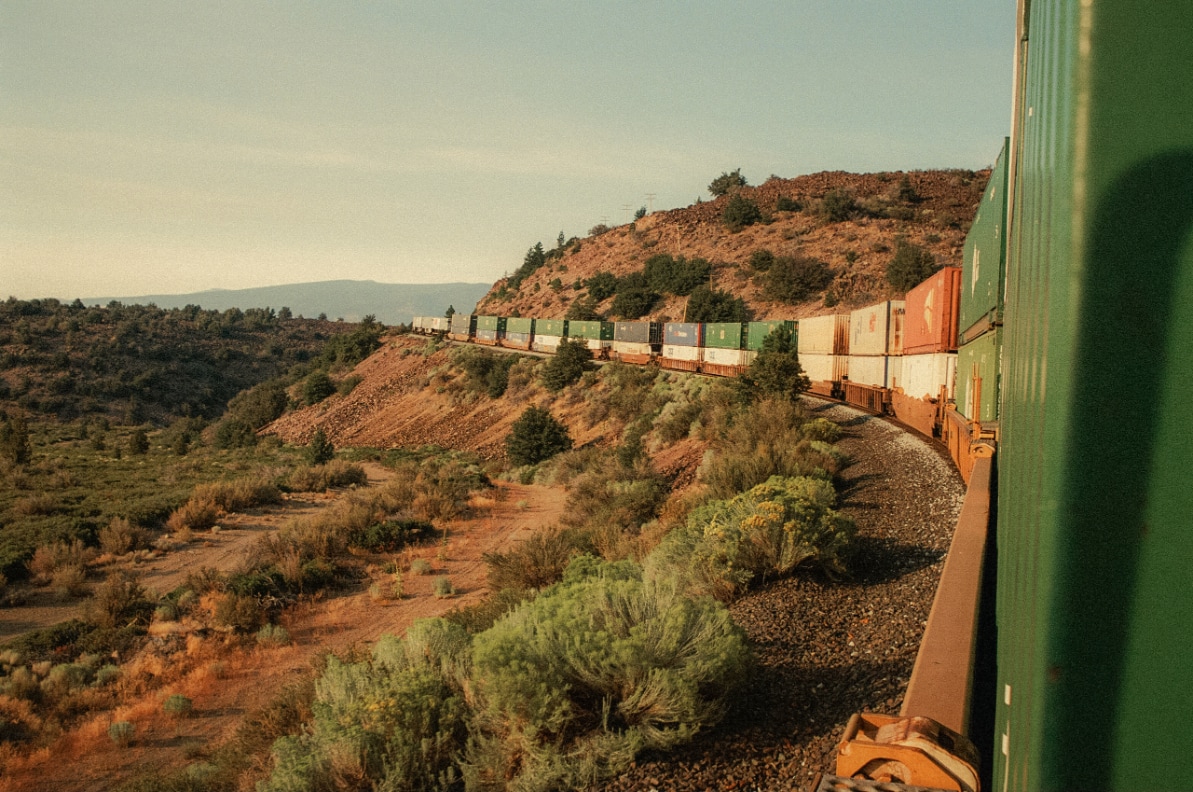
“My most miserable meditation is guided by metals grinding, screeching along the tracks for hours on end. Rocking, jolting, both stationary and in constant movement.”
In this latest Far-Flung, we feature Molly Steele, who has spent nearly a decade joyriding trains across America.

“Mostly my work is self-referential as I feel out for my growing edge on the precipice of dangerous opportunities. It’s created out of longing for other rhythms of life beyond capitalism, beyond public appeal. I’m feeling out for whispers in landscapes, messages conveyed in the composition in collective spaces, and feeling in movement,” says Molly Steele, the photographer behind The Wayward Wind, an ever-evolving journal from nearly a decade of joyriding freight throughout North America.
Born in Gainesville, Florida, Molly was raised on a remote farm, and the surrounding swamps and wetlands became her playground. Growing up there, she sometimes heard about the local kids who rode trains and though she admired them from afar, she never imagined herself in that world.
ArrayArrayMolly went on to study field biology and botany, and it was during her research trips that she picked up photography. At 15, she left home for Los Angeles. Then several years later, an opportunity arose where she was forced to make a decision: to continue working three jobs, or drop everything and take off to pursue her passion.
Her decision (the latter) turned out to be worthwhile, as Molly found her vocation in photography. She’s since travelled extensively throughout the US and the Australian outback, all the while documenting her journeys with her Nikon F3. When she isn’t working on commissioned shoots, Molly devotes her time to personal work, often taking solo trips into the wilderness or riding the rails.
ArrayArrayTrain hopping, which became a common means of travel during the westward expansion of post-Civil War America and the Great Depression of the 1930s, now draws a new generation of riders and has since become a culture in its own right. Despite being prohibited in all US states, people still risk their lives climbing onto freight trains.
For Molly, the intention was “more about experience and relinquishing control, not about photography”. She adds: “More often than not I am just focused on presence as meditation, which is the driving force of why I take these trips.
ArrayArray“I’m still amazed that we can travel by plane or by car. How normal it is to take for granted, to disappear into a movie or a book or online in an airplane. So much exists between points A and B, more and more amiss. Part of what I appreciate so much about riding freight is all that is not chosen but witnessed and felt still.”
In a world where screens are so integrated into daily life, Molly chases experiences that are unmediated by technology, and she mostly photographs on analog film rather than digital. While Molly started out capturing mainly landscapes, her photography has evolved over the years as she’s concentrated on building trust and relationships with people. Film is integral to her process, as it helps her to remain present and cultivate the right settings for meaningful engagement.
ArrayArray“Film has taught me lessons in letting go, radical acceptance, and patience,” she explains. “I’m forever grateful for those lessons and for the warmth film brings to my reportage. My work would not be what it is if I strayed to a digital format.”
Molly also draws inspiration from writers and filmmakers she’s returned to over the years. “The American poet Diane di Prima’s work thuds like a heartbeat for me. Hayao Miyazaki’s films inspire my eye for setting and composition. Theorists like Ariella Azoulay have influenced the backbone of my ethics and awareness as an image-maker. Lastly, I’d be remiss to ignore the contemporary inspiration I glean from my peer and friend Dianna Settles, whose paintings connect me to the themes, people, and places that guide my practice and worldview.”
ArrayArrayThrough her unique style of surreal photojournalism, Molly’s practice is anchored in immersion, spending long stretches of time within a community. In previous projects, she’s focused on off-the-grid lifestyles and people who have retreated from society – people like Cuervo, who lives down a desert dirt track in California, wears a kilt, and spends his days riding mules, chopping wood and foraging dandelion greens.
“For me, process is all about my relationship with environment and connection,” says Molly. “The camera is just a tool for picture-making, but without the trusting relationships that are built with people and place, my work would not be possible.”
ArrayArrayIn one image from The Wayward Wind, the snowy peak of a mountain is rendered in a series of colours, from bottle green through to cyan, the hard edge of the freight car visible in the left-hand corner. Another captured in Louisiana in 2014 shows a man playing harmonica, his face basked in natural light from the window. In another, Molly photographs her feet suspended over the edge of the train as it hurtles through the Texan landscape, the blurred background a reflection of both time and transience.
Looking at Molly’s photos – especially in this post-lockdown phase – it’s hard not to feel a longing to be outdoors, a hunch that human beings aren’t designed to lead sedentary lives trapped at our desks. Instead they’re a reminder for us all to stay curious, a reminder to look up from our phone screens and feel that incredible jolt of being alive, here and now.
Riding trains is “a lesson in need, a taming of restlessness, an opportunity to sit and notice for days on end,” says Molly. “In these moments I’m reminded of the meaninglessness of everything, and filled to the brim with the love of the present. Through this kind of travel, you find yourself wayward, in transit and wonder.”




